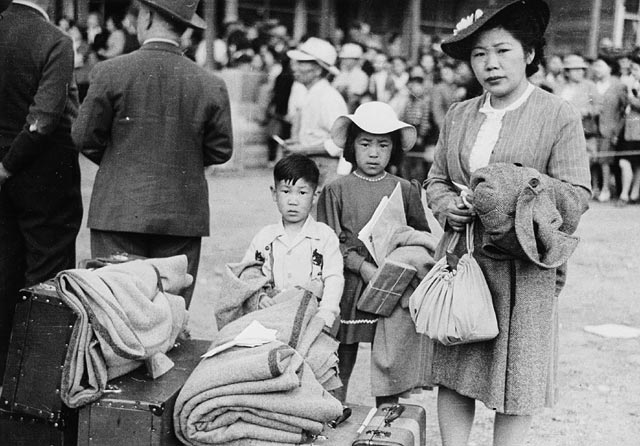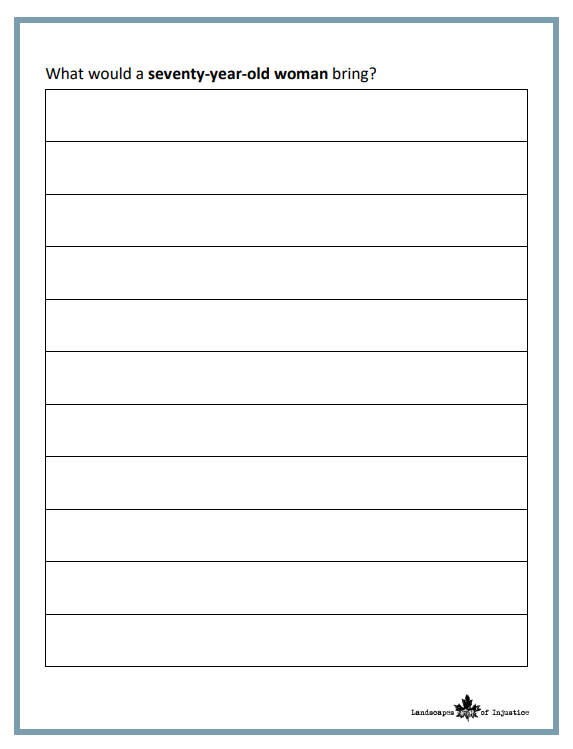Suitcases: Going to Internment
Students evaluate what is important to them by trying to figure out what they would bring if they were suddenly forced out of their homes.
 Scroll down
Scroll down
Why
Know
- Past discriminatory government policies and actions towards Japanese Canadians (internment)
Do
- Ask questions, corroborate inferences, and draw conclusions (Evidence)
- Take stakeholder’s perspectives (Historical Perspectives)
Core Skills
- Explain when something is unfair (Social Responsibility)
- Develop criteria for evaluating design options (Critical Thinking)
- Present info clearly and in organized way (Communication)
First People’s Principles of Learning
- Learning is holistic, reflexive, reflective, experiential, and relational
- Learning requires exploration of one’s identity
How
- Show the PowerPoint for this activity (or start with the “Important Notice” ). Optional: For more information, the teacher could play some of Mary Kitagawa’s interview video about packing for internment: The rest of Mary’s family gets ready to go. “What shall we pack?”
- “What would they bring?” handout
- Students form groups. Each group represents a family, and each student in that group takes on the role of one of the family members. See the “What would they bring?” handout. Students must come to a consensus about what to bring. The belongings must fit in the limited space on the handout. Include :
- practical things (e.g. food, clothing, sewing machines, bedding, pots, tools, etc.)
- things important to the family (e.g. dolls, heirlooms, etc.)
- Each group shares what they would bring for their assigned family member.
- Discuss. (See suggested questions below in Assessment Considerations.)
- Students complete journal reflection. (See suggested journal reflection prompts below in Assessment Considerations.)
Assessment Considerations
SUGGESTED DISCUSSION QUESTIONS
- Was it hard to decide what to bring?
- What did the choices that Japanese Canadians made say about them? What was important to them?
- What would you bring in the same situation? What does that say about you?
SUGGESTED JOURNAL REFLECTION PROMPTS
- What is important to me? What do I value? What I would bring if I were forced out of my home suddenly would say a lot about what was important to me. What Japanese Canadians brought says a lot about what was important to them.
- What was it like to lose your home, your possessions, and your community due to prejudice? How do you deal with this kind of loss?
Extension and Variations
The Nikkei National Museum has a sample suitcase available for rent. It contains items that a Nikkei family might have brought with them. Students enjoy looking at and touching these facsimiles of the artifacts.
In the Suitcase Project, Kayla Isomura asked Japanese Canadians and Americans what they would have brought if they had to leave their homes at a moment’s notice. The results are fascinating. Participants brought everything from small jars of food to tools to ukuleles. After viewing Kayla’s site, students could list the things they would bring, or they could take photos of what they would bring, or they could actually bring to school what they would bring in luggage they could carry.
Toys were scarce during the internment years and most children made their own fun. They played hockey and baseball, hiked, and swam in the local lakes. In Sandon, where a family had brought some equipment, kendo was popular. Kendo is Japanese fencing. Another popular martial art was judo. Also, small bags were made from leftover material and filled with rice, peas, or beans to make beanbag dolls and balls. To simulate how Japanese Canadian internees had to create their own entertainment from the limited resources available, have students try these activities:
- Using a cereal box from home, students create a jigsaw puzzle. They can either use the picture from the front of the box or draw a new picture on the inside of the box and then cut the picture into puzzle pieces. Those pieces would then be mixed up for a partner to put back together into the picture.
- Using newspaper or whatever paper is available, students can fold the paper into objects using origami (the Japanese art of paper folding).
- Sew a beanbag toy.

